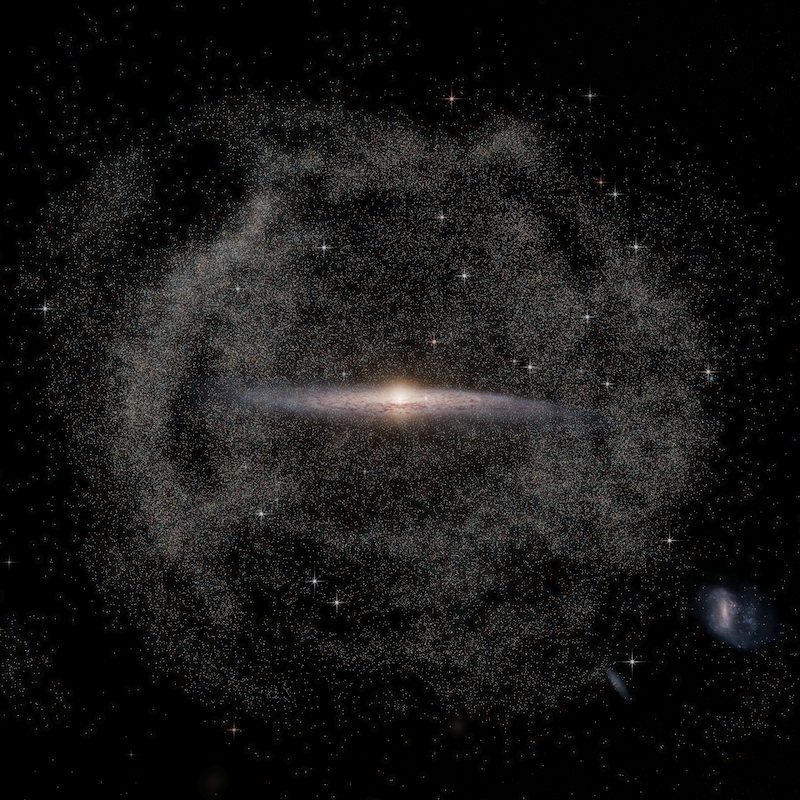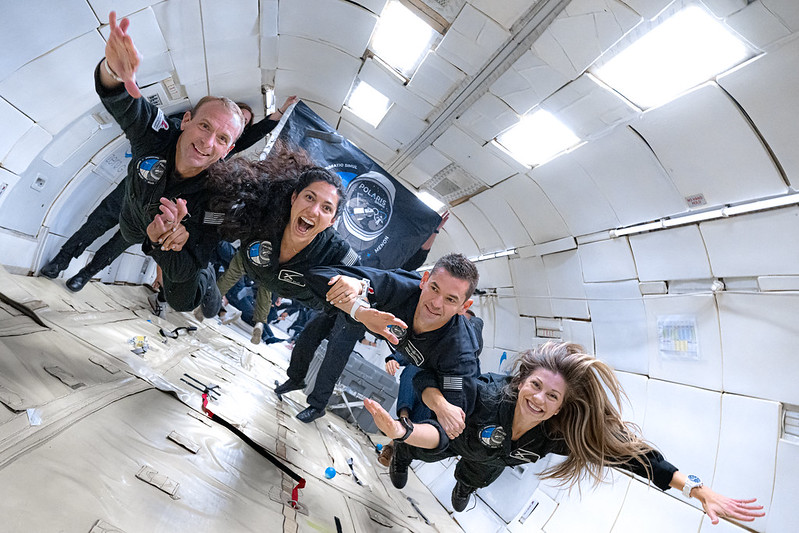ESA originally published this article on June 6, 2024. Edits by EarthSky.
Galaxy collisions are not a rare event
Our galaxy has collided with many others in its lifetime. ESA’s Gaia space telescope now reveals that the most recent of these crashes took place billions of years later than we thought.
The Milky Way has grown over time as other galaxies have approached, collided with, and been torn apart as our galaxy consumed them. Each collision triggered wrinkles that still ripple through different families of stars. And it affects how they move and behave in space.
Gaia space telescope studies these wrinkles
One of Gaia’s aims is to unravel the history of our galaxy by studying these wrinkles. It’s doing this by pinpointing the positions and motions of over 100,000 stars near to our own. That’s a tiny fraction of the about 2 billion sources it observes.
? @ESAGaia reveals that the Milky Way’s last major collision was surprisingly recent!
Gaia unravels our history by studying the wrinkles created by collisions, but there’s a catch. Like Benjamin Button, our galaxy is getting less wrinkly over time ? pic.twitter.com/lUUYSyj7Qh
— ESA Science (@esascience) June 6, 2024
The lead author of this study, Thomas Donlon of the Rensselaer Polytechnic Institute and University of Alabama in Huntsville, Alabama, said:
We get wrinklier as we age, but our work reveals that the opposite is true for the Milky Way. It’s a sort of cosmic Benjamin Button, getting less wrinkly over time. By looking at how these wrinkles dissipate over time, we can trace when the Milky Way experienced its last big crash, and it turns out this happened billions of years later than we thought.
These galactic wrinkles were only found by Gaia in 2018. This study is the first to accurately determine the timing of the collision that made the wrinkles. The study compared observations with cosmological simulations.
Strange motions
The Milky Way’s halo contains a large group of stars with unusual orbits. Our galaxy probably adopted many of those stars during an event that astronomers call the last major merger. As the name suggests, this is the last time our galaxy experienced a significant collision with another galaxy. Researchers believe it was a massive dwarf galaxy that flooded the Milky Way with stars that pass very close to our galaxy’s center.
Scientists had dated this merger to between 8 and 11 billion years ago, when the Milky Way was in its infancy. It is known as Gaia-Sausage-Enceladus (GSE). But data from Gaia – released as part of the telescope’s Data Release 3 in 2022 – suggests that another merger may have delivered the unusually moving stars.
Wrinkles suggest a more recent galactic collision
Co-author Heidi Jo Newberg, also of Rensselaer Polytechnic Institute, added:
For the wrinkles of stars to be as clear as they appear in Gaia data, they must have joined us less than 3 billion years ago, at least 5 billion years later than was previously thought. New wrinkles of stars form each time the stars swing back and forth through the center of the Milky Way. If they’d joined us 8 billion years ago, there would be so many wrinkles right next to each other that we would no longer see them as separate features.
The finding suggests that rather than these stars originating from the ancient GSE merger, they must have come from a more recent event dubbed the Virgo Radial Merger. That merger took place less than 3 billion years ago.
Rewriting history
There is evidence for the GSE merger taking place far back in the Milky Way’s history. However, recent work has questioned whether a massive ancient merger is needed to explain the properties of the Milky Way as we see it today. And also, whether the stars originally associated with the GSE are from the same merger event.
In 2020, Thomas led the study that identified wrinkles of stars in the Milky Way, and compared these to simulations of different possible mergers. Thomas explains:
We can see how the shapes and number of wrinkles change over time using these simulated mergers. This lets us pinpoint the exact time when the simulation best matches what we see in real Gaia data of the Milky Way today – a method we used in this new study too. By doing this, we found that the wrinkles were likely caused by a dwarf galaxy colliding with the Milky Way around 2.7 billion years ago. We named this event the Virgo Radial Merger.
A closer look at recent mergers
Since then, Thomas and colleagues have further explored this merger. They’ve been slowly refining the idea that many of the oddly moving stars and debris in the Milky Way’s inner halo were delivered to our galaxy from a much more recent galaxy collision than the GSE. They have also clarified that the stars originally associated with the GSE may have originated from multiple mergers, some ancient.
Thomas added:
The Milky Way’s history is constantly being rewritten at the moment, in no small part thanks to new data from Gaia. Our picture of the Milky Way’s past has changed dramatically from even a decade ago, and I think our understanding of these mergers will continue to change rapidly.
This result – that a large portion of the Milky Way only joined us within the last few billion years – is a big change from what astronomers thought up until now. Many popular models and ideas about how the Milky Way grows would expect a recent head-on collision with a dwarf galaxy of this mass to be very rare.
It’s likely that the Virgo Radial Merger brought in a family of other small dwarf galaxies and star clusters with it. So they would have all joined the Milky Way at around the same time. Future exploration will reveal which of these smaller objects that were previously thought to be related to an ancient GSE are related to a more recent Virgo Radial Merger instead.
Bottom line: The Milky Way has collided with many other galaxies during its history. The Gaia space telescope found that the most recent of these crashes took place billions of years later than we thought.
VIA ESA




